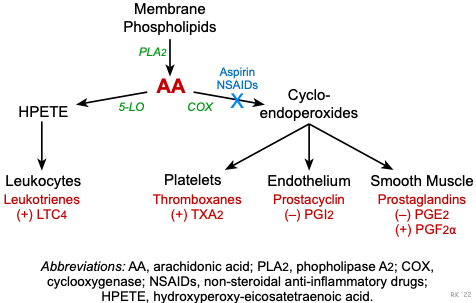### Date : 2024-11-05 16:41
### Topic : Aspirin-exacerbated respiratory disease #pulmonology
----
**Aspirin-Exacerbated Respiratory Disease (AERD)**, also known as **Samter's Triad**, is a chronic medical condition characterized by a **combination of asthma, chronic rhinosinusitis with nasal polyps, and sensitivity to aspirin or other NSAIDs (nonsteroidal anti-inflammatory drugs)**. In individuals with AERD, taking aspirin or other NSAIDs can trigger respiratory symptoms, including severe asthma exacerbations, which can be life-threatening if not managed promptly.
### Pathophysiology of AERD
The exact cause of AERD is not fully understood, but it is believed to involve dysregulation in the **arachidonic acid pathway**, leading to an imbalance in certain inflammatory mediators:

1. **Arachidonic Acid Metabolism**:
- Aspirin and NSAIDs inhibit **cyclooxygenase-1 (COX-1)**, an enzyme responsible for producing prostaglandins, which are involved in normal respiratory function.
- This inhibition shifts arachidonic acid metabolism towards the **5-lipoxygenase pathway**, resulting in overproduction of **leukotrienes** (particularly leukotriene B4, C4, D4, and E4), which are potent bronchoconstrictors and inflammatory mediators.
2. **Increased Leukotriene Production**:
- Leukotrienes cause bronchoconstriction, mucus production, and increased vascular permeability, contributing to asthma symptoms, sinus inflammation, and polyp formation.
- Patients with AERD often have elevated levels of leukotrienes and eosinophils, both of which are involved in inflammation and allergic reactions.
3. **Nasal Polyps and Chronic Rhinosinusitis**:
- AERD patients commonly develop nasal polyps, which are growths of inflamed tissue within the nasal passages and sinuses, causing chronic sinusitis, nasal obstruction, and a diminished sense of smell.
- Chronic inflammation in the upper airways contributes to the persistence of polyps and sinus infections.
### Symptoms of AERD
Patients with AERD typically present with a characteristic triad of symptoms:
1. **Asthma**:
- Asthma symptoms, including wheezing, shortness of breath, chest tightness, and cough, may vary from mild to severe.
- Asthma attacks are often worsened by exposure to aspirin or other NSAIDs.
2. **Chronic Rhinosinusitis with Nasal Polyps**:
- Persistent nasal congestion, facial pressure, postnasal drip, and loss of smell are common.
- Nasal polyps are often recurrent and may require surgical removal if they obstruct airflow or cause frequent sinus infections.
3. **Aspirin or NSAID Sensitivity**:
- Symptoms typically develop within minutes to hours after ingestion of aspirin or NSAIDs and include nasal congestion, sneezing, rhinorrhea, wheezing, coughing, and shortness of breath.
- These reactions are not IgE-mediated, meaning they are not a true allergy but rather an intolerance due to the leukotriene pathway shift.
### Diagnosis of AERD
Diagnosis of AERD involves a combination of clinical history, testing, and sometimes aspirin challenge:
1. **Clinical History**:
- Diagnosis is strongly suggested by a history of asthma, nasal polyps, chronic rhinosinusitis, and respiratory symptoms triggered by aspirin or NSAIDs.
2. **Aspirin Challenge Test**:
- A supervised oral or nasal aspirin challenge can confirm AERD. Under medical supervision, the patient receives small, gradually increasing doses of aspirin, observing for symptoms.
- If the challenge induces asthma symptoms or nasal congestion, AERD is confirmed.
3. **Leukotriene Levels**:
- Elevated leukotriene levels in the blood or urine can support the diagnosis, although these tests are not required.
4. **Nasal Endoscopy and Sinus Imaging**:
- Endoscopy or CT imaging can detect nasal polyps and assess the extent of sinus inflammation.
### Treatment of AERD
The treatment of AERD involves a combination of medications to control inflammation, manage asthma, and improve quality of life. Options include:
1. **Leukotriene Modifiers**:
- **Montelukast** and **zafirlukast** block leukotriene receptors, while **zileuton** inhibits 5-lipoxygenase, reducing leukotriene production. These medications are effective in decreasing inflammation and improving symptoms in AERD patients.
2. **Inhaled Corticosteroids (ICS)**:
- Inhaled corticosteroids help control asthma symptoms by reducing airway inflammation. They are often combined with long-acting beta-agonists (LABAs) for better asthma control.
3. **Nasal Corticosteroids**:
- Corticosteroid nasal sprays reduce inflammation in the nasal passages and improve symptoms of chronic rhinosinusitis and nasal polyps.
4. **Aspirin Desensitization**:
- Aspirin desensitization involves gradually introducing aspirin in small, increasing doses under medical supervision until the patient can tolerate a full dose without adverse effects.
- After desensitization, patients typically continue daily aspirin therapy, which can reduce the need for sinus surgery, decrease polyp recurrence, and improve asthma control.
5. **Biologic Therapies**:
- **Dupilumab** (anti-IL-4/IL-13) and **omalizumab** (anti-IgE) are biologics that target specific inflammatory pathways and have shown effectiveness in reducing symptoms of nasal polyps, asthma, and overall inflammation in AERD.
6. **Surgical Intervention**:
- Sinus surgery may be necessary to remove obstructive nasal polyps, especially in patients with recurrent infections or significant nasal obstruction. However, polyps may recur after surgery, making medical therapy critical postoperatively.
7. **Avoidance of NSAIDs**:
- Patients with AERD should avoid aspirin and NSAIDs unless they undergo aspirin desensitization. Acetaminophen (paracetamol) is generally safe, though some patients may need to use it cautiously.
### Prognosis and Management
With appropriate management, individuals with AERD can achieve good control of their symptoms and prevent severe asthma attacks. Regular follow-ups, medication adherence, and monitoring for recurrent nasal polyps or asthma exacerbations are essential.
### Summary
- **AERD (Aspirin-Exacerbated Respiratory Disease)** is characterized by asthma, chronic rhinosinusitis with nasal polyps, and sensitivity to aspirin/NSAIDs.
- **Pathophysiology**: Inhibition of COX-1 by NSAIDs shifts the arachidonic acid pathway toward leukotriene production, causing bronchoconstriction and inflammation.
- **Diagnosis**: Based on clinical history and sometimes confirmed by aspirin challenge.
- **Treatment**: Includes leukotriene modifiers, corticosteroids, biologics, aspirin desensitization, and avoidance of NSAIDs.
Managing AERD requires a tailored approach to reduce symptoms, prevent asthma attacks, and maintain airway health.
### Reference:
-
### Connected Documents:
-